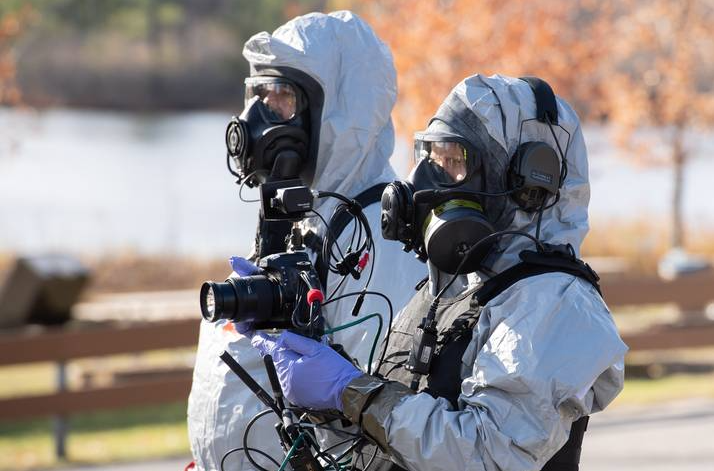
RCMP-led Chemical, Biological, Radiological, Nuclear, and Explosives response team holds training exercise
The RCMP-led Chemical, Biological, Radiological, Nuclear, and Explosives response team holds three national training exercises each year to help RCMP officers and partner agencies prepare for such events.
A team of RCMP officers is leading national efforts to keep Canadians safe from chemical, biological, radiological, and nuclear attacks, by not only training responders but by spreading the word about the group’s capabilities.
The RCMP leads Canada’s Chemical, Biological, Radiological, Nuclear and Explosives (CBRNE) response team. It’s called in to respond to incidents caused by devastating agents – often used in terrorist attacks – that can cause large-scale damage and death.
Inspector Catherine Colthart, officer in charge of CBRNE operations, heads a small team of 11 officers that prepares RCMP colleagues and partners for a worst-case CBRNE event that everyone hopes will never happen.
“A major focus is trying to get more people trained across the country and to spread awareness about the program,” she says. “Threats are increasing; bad actors around the world can search anything online to make anything they want, so you definitely need a response like CBRNE.”
Jumping into action
The response team, which includes members of the Canadian Armed Forces (CAF) and several other government departments, is mobilized when needed. To date, the federal team has only been fully deployed four times.
One of those instances occurred in September 2020 when the national CBRNE response team, supported by local police, raided the home of a Quebec woman later charged with sending a letter laced with the poison ricin to former United States President Donald Trump. In January 2023, Pascale Ferrier pleaded guilty to that and other biological weapons charges in a United States court.
The police of jurisdiction are always involved in the initial response to a suspected or actual CBRNE attack. When it becomes apparent to local officials that a CBRNE event in their area requires the attention of the national CBRNE team, S/Sgt. Rob Wilson, the non-commissioned officer in charge of the team’s operations, is one of the first federal points of contact.
“I reach out to my federal scientific partners and they can give me their advice on how bad it could be,” says Wilson, who then works on potential response plans while pushing information up the chain-of-command within the RCMP.
If a full-scale CBRNE response is needed, team members are capable of detecting, sampling, identifying, and rendering safe any explosive and dispersal devices. The team also looks for trace evidence and collects samples to determine if a chemical, biological radiological or nuclear weapon of mass destruction was used.
Keeping skills sharp
To be fully prepared, CBRNE members based in several cities including Ottawa, Vancouver, Edmonton, and Halifax, spend months organizing and planning simulated CBRNE events for police, fire officials, paramedics, and others.
Three large-scale training events are normally held each year, and include the CAF, the Public Health Agency of Canada, Environment Canada, Defence Research and Development Canada Suffield, and the Federal Radiological Assessment Team.
During each event, the RCMP and its partners engage in mock evidence collection wearing full-body protective suits and respiratory equipment. The training also tests the skills of forensic and bomb-disposal experts to safely collect evidence from a simulated contaminated scene.
Sergeant William Robinson, a CBRNE regional coordinator in Edmonton, helps prepare officers in the Prairie Provinces and in the North for CBRNE events and he builds and maintains partnerships with other police agencies. He planned a training exercise in Regina in February, which, among other activities, tested the high-tech equipment in cold Canadian temperatures.
“We have a lot of high-tech gear that isn’t user friendly in the cold,” says Robinson. “But that’s why we hold these exercises: to figure out how we’re going to deal with these types of challenges.”
Colthart adds that the work is important because it builds awareness about the CBRNE response.
“A lot of people hear about us, but don’t fully understand what we do,” she says. “The exercise allows the RCMP, CAF, and other partners the ability to showcase what they can do for local police.”

